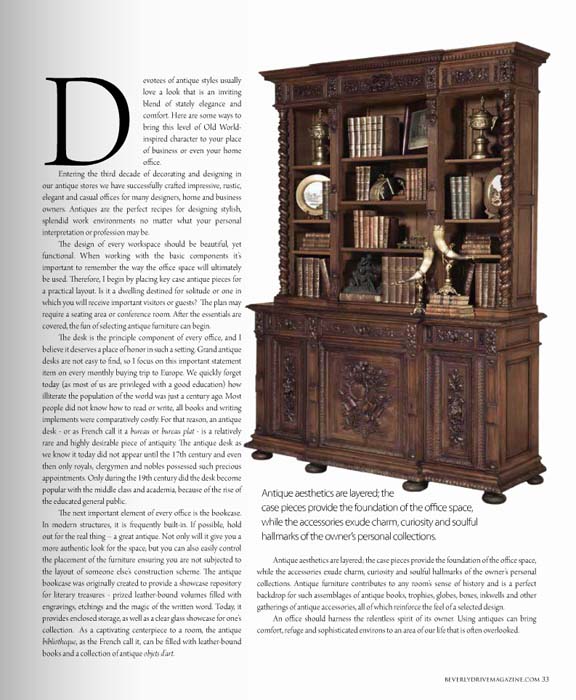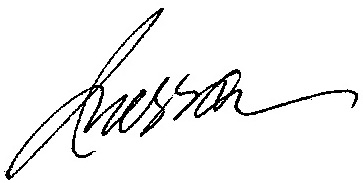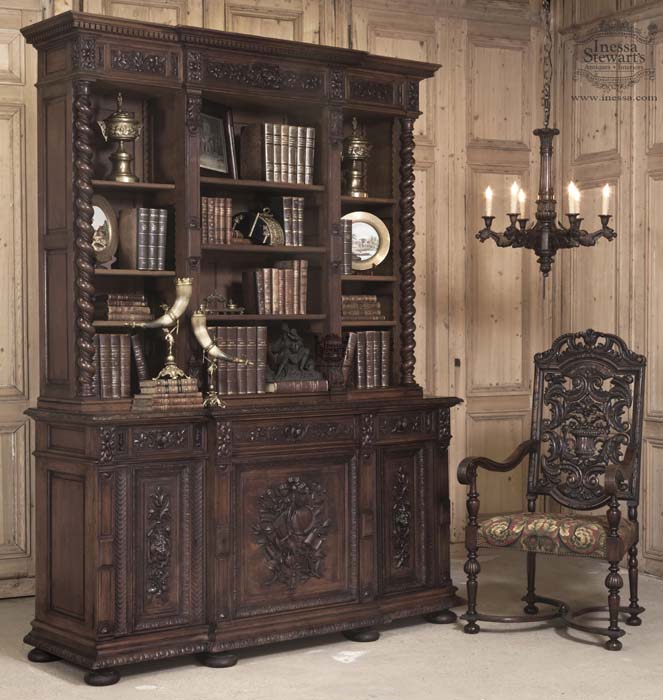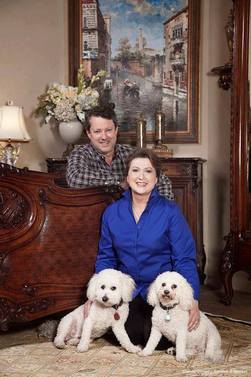 Last year one my Antiques in Style articles escaped our antique blog coverage during a busy holiday season. The article was entitled “Impressive Offices”, and was about creating home or business workplaces using antique furniture such as antique desks, antique bookcases, and the like, creating unique one-of-a-kind places to work. If you have not have a chance to read it, John Stewart worked very hard to install my monthly Beverly Drive Magazine articles on our website, first appearing in August of 2012, for your pleasure. They can be found on the “About Us” page. (John is continually tinkering and improving the website daily, and if you like our renovations and upgrades, shoot him an email, he will love to hear from you~) Using antiques in the office is a concept I grew up with as my mother, an engineer, writer and poet always created in our home an office full of antique volumes. She decorated with beloved antique furniture and objects that inspired her, providing a place where she could go on the weekends to write her novel and books of poetry. If you desire to devise this space of refuge, work or creativity for your pursuits by using antiques, read on by clicking here!
Last year one my Antiques in Style articles escaped our antique blog coverage during a busy holiday season. The article was entitled “Impressive Offices”, and was about creating home or business workplaces using antique furniture such as antique desks, antique bookcases, and the like, creating unique one-of-a-kind places to work. If you have not have a chance to read it, John Stewart worked very hard to install my monthly Beverly Drive Magazine articles on our website, first appearing in August of 2012, for your pleasure. They can be found on the “About Us” page. (John is continually tinkering and improving the website daily, and if you like our renovations and upgrades, shoot him an email, he will love to hear from you~) Using antiques in the office is a concept I grew up with as my mother, an engineer, writer and poet always created in our home an office full of antique volumes. She decorated with beloved antique furniture and objects that inspired her, providing a place where she could go on the weekends to write her novel and books of poetry. If you desire to devise this space of refuge, work or creativity for your pursuits by using antiques, read on by clicking here!
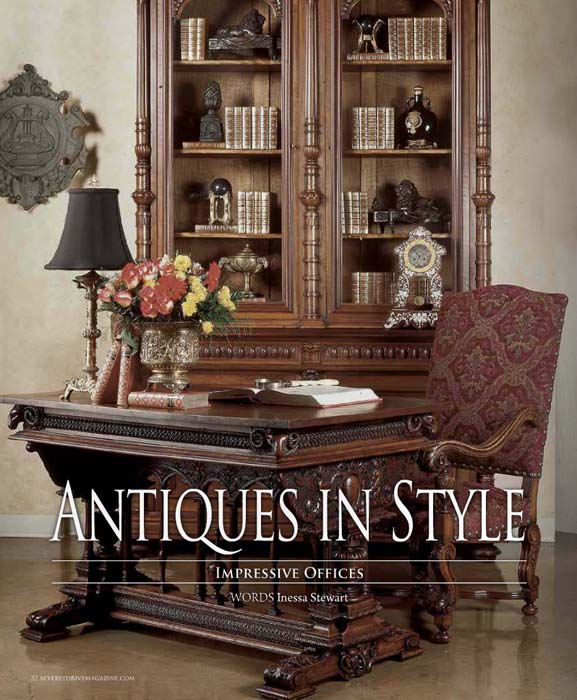
Devotees of antique styles usually love a look that is an inviting blend of stately elegance and comfort. Here are some ways to bring this level of Old World- inspired character to your place of business or even your home office.
Entering the third decade of decorating and designing in our antique stores we have successfully crafted impressive, rustic, elegant and casual offices for many designers, home and business owners. Antiques are the perfect recipes for designing stylish, splendid work environments no matter what your personal interpretation or profession may be.
The design of every workspace should be beautiful, yet functional. When working with the basic components it’s important to remember the way the office space will ultimately be used. Therefore, I begin by placing key case antique pieces for a practical layout. Is it a dwelling destined for solitude or one in which you will receive important visitors or guests? The plan may require a seating area or conference room. After the essentials are covered, the fun of selecting antique furniture can begin.
The desk is the principle component of every office, and I believe it deserves a place of honor in such a setting. Grand antique desks are not easy to find, so I focus on this important statement item on every monthly buying trip to Europe. We quickly forget today (as most of us are privileged with a good education) how illiterate the population of the world was just a century ago. Most people did not know how to read or write, all books and writing implements were comparatively costly. For that reason, an antique desk – or as French call it a bureau or bureau plat – is a relatively rare and highly desirable piece of antiquity. The antique desk as we know it today did not appear until the 17th century and even then only royals, clergymen and nobles possessed such precious appointments. Only during the 19th century did the desk become popular with the middle class and academia, because of the rise of the educated general public.
The next important element of every office is the bookcase. In modern structures, it is frequently built-in. If possible, hold out for the real thing – a great antique. Not only will it give you a more authentic look for the space, but you can also easily control the placement of the furniture ensuring you are not subjected to the layout of someone else’s construction scheme. The antique bookcase was originally created to provide a showcase repository for literary treasures – prized leather-bound volumes filled with engravings, etchings and the magic of the written word. Today, it provides enclosed storage, as well as a clear glass showcase for one’s collection. As a captivating centerpiece to a room, the antique bibliotheque, as the French call it, can be filled with leather-bound books and a collection of antique objets d’art.
Antique aesthetics are layered; the case pieces provide the foundation of the office space, while the accessories exude charm, curiosity and soulful hallmarks of the owner’s personal collections. Antique furniture contributes to any room’s sense of history and is a perfect backdrop for such assemblages of antique books, trophies, globes, boxes, inkwells and other gatherings of antique accessories, all of which reinforce the feel of a selected design.
An office should harness the relentless spirit of its owner. Using antiques can bring comfort, refuge and sophisticated environs to an area of our life that is often overlooked.
